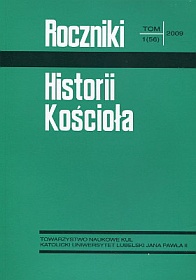Tax Revolt in Antioch (387) in the Light of Libanius’ Speeches and John Chrysostom’s Homilies. Rhetoric and Historical Facts
Abstract
The present article discusses the revolt that broke out in Antioch in 387 because Emperor Theodosius the Great announced imposition of new taxes that were a considerable burden for all the citizens of Antioch. First, on the basis of John Chrysostom’s homilies belonging to the series Ad populum Antiochenum and Libanius’ speeches (especially Speech XIX) the course of events is presented. Then the arguments are presented that were used by the two authors when they tried to reconcile Theodosius and Antioch. The speakers showed that the people of Antioch are not solely responsible for the riots and that is why they should not be punished for insulting the emperor’s statues. They ardently put the blame for the rebellion on the traditional rhetoric „scapegoats” and they tried to convince the Emperor that he should show his forgiveness by restoring the signs of his patronage, like the emperor’s statues, baths, the hippodrome, theaters and the municipal status. Finally they laid responsibility on the „demon” - a supernatural power that could not fall under the competence of courts of justice.
Analysis of Libanius’ speeches and John Chrysostom’s homilies as historical sources for research on the revolt of 387 is justified, despite their rhetoric nature. On the other hand, examining the misty subtexts found in those texts in the hope of identification of a particular individual or group responsible for instigating the rebellion becomes futile.
References
Ameringer T., The Stylisic Influence of the Second Sophistic on the Panegyrical Sermons of St. John Chrysostomus, Washington 1921.
Brown P., Power and Persuasion in Late Antiquity. Towards a Christian Empire, Madison 1992.
Browning R., The Riot of A.D. 387 in Antioch. The Role of the Theatrical Claques in the Later Empire, „The Journal of Roman Studies” 42(1952), s. 13-20.
Cameron A., Circus Factions: Blues and Greens at Byzantium, Oxford 1967.
Ceran W., Teodozjusz Wielki, Kraków 2003.
Clark D. L., Rhetoric in Graeco-Roman Education, New York 1957.
Downey G., A Study of the Comites Orientis and the Consulares Syriae, Princeton 1939.
French D.R., Rhetoric and the Rebellion of A.D. 387 in Antioch, „Historia” 47(1998), s. 468-484.
Hill F.I., The Rhetoric of Aristotle, w: A Synoptic History of Classical Rhetoric, red. J. J. Murphy, New York 1972, s. 19-76.
Kelly J.N.D., Złote usta. Jan Chryzostom – asceta, kaznodzieja, biskup, przekł. K. Krakowczyk, Bydgoszcz 2001.
Kennedy G., The Art of Rhetoric in the Roman World 300 B.C – A.D. 300, Princeton 1973.
Liebeschuetz J.H.W.G., Antioch. City and Imperial Administration in the Later Roman Empire, Oxford 1972.
Maat W.A., A Rhetorical Study of St. John Chrysostom's «De Sacerdotio», Washington D.C. 1944.
MacCormack S., Art and Ceremony in Late Antiquity, Berkeley 1981.
Marrou H.I., Historia wychowania w starożytności, przekł. pol. S. Łoś, Warszawa 1969, s. 285-286.
McMullen R., Enemies of the Roman Order, Cambridge (Massachusetts) 1966.
Nadeau R., Hermogenes «On Stasis». A Translation with an Introduction and Note, „Speech Monographs” 31(1964), s. 361-424.
Ochs D.J., Cicero's Rhetorical Theory, w: A Synoptic History of Classical Rhetoric, red. J.J. Murphy, New York 1972, s. 90-150.
Paverd F. van de, St. John Chrysostom. The Homilies on the Statues, (Orientalia Christiana Analecta, t. 239), Roma 1991.
Petit P., Libanius et la vie municipale à Antioche au IVe siècle après J.-C., Paris 1955.
Rudé G., The Crowd in History 1730-1884, New York 1961.
Smelser N.J., The Theory of Collective Behavior, New York 1962.
Sondel J., Słownik łacińsko-polski dla prawników i historyków, Kraków 1997.
Wiemer H.W., Libanius on Constantine, „The Classical Quarterly” 54(1994), s. 511-524.
Wilken R.L., John Chrysostom and the Jews. Rhetoric and Reality in the Late 4th Century, Berkeley 1983.
Copyright (c) 2009 Roczniki Historii Kościoła

This work is licensed under a Creative Commons Attribution-NonCommercial-NoDerivatives 4.0 International License.

